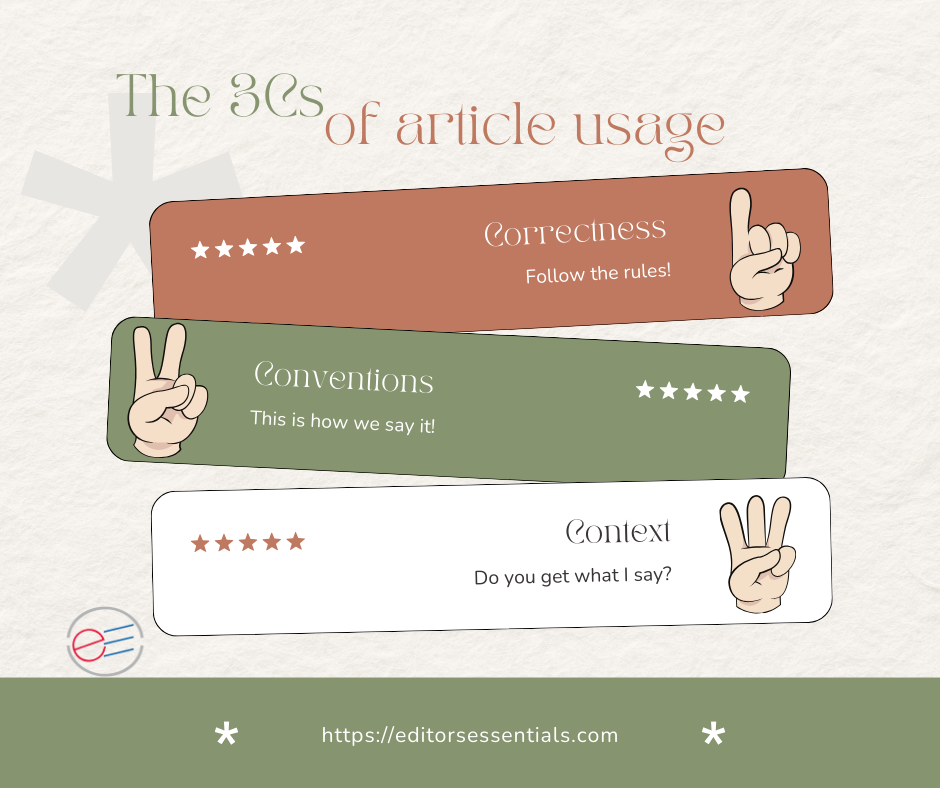Mastering the intricacies of article usage is a pivotal milestone in achieving fluency in the English language. It is a domain where adherence to rules, familiarity with conventions, and acute sensitivity to context converge. Compounding this complexity is the fact that some languages don’t have articles. For example, articles aren’t used in Chinese or Russian, so learners from these countries might struggle to understand when and how to use them in English. Moreover, some languages use articles differently or have different rules. For example, in Spanish, articles are used more often and have gender distinctions.
To approach this linguistic challenge with clarity and precision, we break down the learning process into three distinct categories: correctness, conventions, and context. These three dimensions provide unique insights into the rules that govern articles, the idiomatic expressions that shape their usage, and the dynamic contextual cues that guide their application.
By understanding the different layers of article usage, one can systematically approach to the correct use of articles.
Correctness: Guided by Rules
The first cornerstone in this journey lies in the realm of correctness. Here, learners delve into the well-defined rules that govern the selection and placement of articles. This includes discerning between “a” and “an” based on sound and understanding when to omit articles entirely. A solid grasp of correctness establishes a firm foundation upon which the nuances of article usage are built.
Here are the reasons why ensuring correctness in article usage can be difficult and how to overcome them:
Unclear rules: English articles have tricky rules that can be sometimes difficult to grasp. For instance, the choice between “a” and “an” is determined by the sound that follows it, not the actual first letter of the word. Begin by learning the basic rules governing the use of articles in English. Understand when to use “a”, “an”, and “the” as well as when articles are not needed.
Countable vs. uncountable nouns: Some nouns can be counted (e.g., “a book” vs “two books”) while others can’t (e.g., “water”). Understanding which articles to use with countable and uncountable nouns can be challenging. Look up if you are not sure that a word is countable or uncountable. Dictionaries include information about whether the noun is countable or uncountable.
Focus on pronunciation: The choice between “a” and “an” is governed by how the word following the article is pronounced, not how it is spelt. Words that begin with vowel pronunciation are preceded by “an”; those that begin with consonant pronunciation are preceded by “a”. All standard dictionaries provide the pronunciation key for the entries. With online dictionaries, it is even possible to hear the pronunciation.
Conventions: Embracing Idiomatic Expressions
Beyond mere rules, the second facet encompasses conventions, often manifested through idiomatic expressions. This entails familiarizing yourself with the specific instances where articles are used in distinctive ways, such as with musical instruments (“I play the violin” vs “I bought a violin”) or in referencing places like churches, colleges, and hospitals. Here, adherence to established norms and practices within the language plays a pivotal role in achieving linguistic fluency.
In order to master the conventions in article usage, read a variety of English texts, including books, articles, and essays, paying attention to how articles are used in different contexts and styles of writing.
Context: Discerning Generic from Specific
The third and final dimension revolves around context, the dynamic interplay between generic and specific references. Context sensitivity dictates the choice of articles, delineating whether a noun is treated in a broad, generic sense or as a particular, specific entity. The choice of article often depends on the context and the speaker’s intent. This can be subtle and hard to teach through strict rules. This critical discernment ensures that article usage aligns seamlessly with the intended meaning, enabling effective communication in diverse situations.
There are cases where articles might not be necessary or can be omitted, which can be confusing. For instance, English uses definite articles (“the”) with plural nouns when referring to a specific group of things (e.g., “the cats”). There is a whole world of nouns that take a zero article!
Use context as a guide: Pay close attention to the context in which articles are used in reading materials, conversations, and written texts. Analyze how native speakers use articles.
Final Thoughts
Given these challenges, it’s important that copyeditors receive targeted instruction, engage in activities that focus on article usage, and get feedback on their writing to improve their proficiency in this area. Additionally, patience and practice are key to developing a strong grasp of English articles.
By understanding and internalizing these three fundamental pillars – correctness, conventions, and context – copyeditors can navigate the intricacies of article usage with greater clarity and precision. This comprehensive approach empowers learners to not only apply rules, but also embrace idiomatic expressions and leverage contextual cues, ultimately enhancing their proficiency in the English language.
Once these three dimensions are understood, you can improve the understanding of article usage through a combination of focused study, practice, and exposure to English. Here are some effective strategies:
- Practice and exposure: Mastery of articles often comes with extensive exposure to the language and practice in different contexts. Copyeditors with English as a second language (ESL) might not have as much exposure as native speakers.
- Practice with exercises: Engage in exercises specifically designed to target article usage. There are many online resources, textbooks, and ESL workbooks that offer practice activities.
- Get feedback on writing: Seek feedback from teachers, tutors, or native English speakers on your written work. They can help identify and correct article usage errors.
- Use grammar checking tools: Utilize grammar checking tools and language learning apps that provide feedback on article usage. These tools can be helpful for self-study.
- Join English language communities: Engage with online forums, discussion groups, or language exchange programs where you can interact with native speakers and other learners.
- Seek professional guidance: Consider enrolling in a course or hiring a tutor who can provide personalized instruction and guidance on article usage.
- Learn from mistakes: When you make mistakes, take note of them and try to understand why they occurred. Use them as learning opportunities to improve.
- Be patient and persistent: Developing a strong grasp of article usage takes time and practice. Don’t get discouraged by initial challenges.
Remember that improving article usage is a gradual process. Consistent practice and wide reading will help you become more proficient over time.





0 Comments